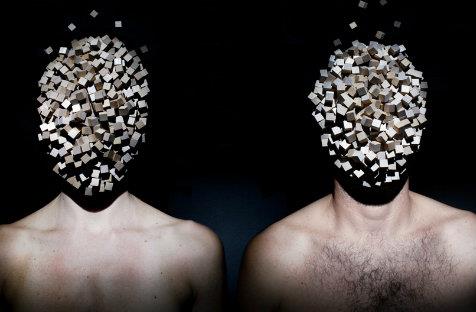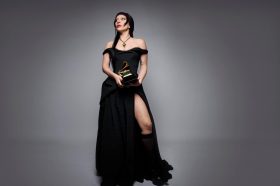Two intriguing short dance pieces, wonderfully performed, that examine the very fabric of our modern technological world. Both are duets and utilise performer-operated lighting and live set manipulation to create a constantly evolving landscape of shimmering relativity.
Both Kirstie McCracken and Lee Serle are extraordinary, and revel in Byron Perry’s challenging choreographic style. The two oozed stage presence and displayed a wonderful, fluid ‘line’ of the body. As a company, Force Majeure push the boundaries of what is considered contemporary dance and bring us works that communicate with the audience in a fresh, challenging way.
Perry, who joined Force Majeure this year as Associate Director, reminds us in the programme notes: ‘The title references a term first coined by George Orwell in his seminal work 1984 in which the term ‘Double Think’ is defined as the ability to hold two diametrically opposed ideas in your head at the same time and believe both. This work is not a n investigation into that book or its themes but the term ‘Double Think’ seemed to me like an elegant description of the concepts we were playing with in the studio’.
The first short piece, Google Box, was inspired by a 2005 article about the end of analogue television and all the changeovers therein involved. A nostalgic, humorous look at society’s relationship and dependence on the ubiquitous TV set, in which Serle is a ‘TV monster’ with a small red television set as a head, the piece begins and ends with excellent use of shadow and silhouette.
Choreographically, it opens with short, sharp, snappy, movements and includes references to sports movements such as golf, and even some breakdance-like moves. This leads to some marvellous, sinuous, slithery floor work, and a duet where Serle is twisted and manipulated like a giant TV antennae to obtain better reception.
All seems well for a little while; there is a joyous dance and then the TV ‘creature’ suddenly freezes and collapses in robotic slow-motion. McCracken anxiously tends him and he briefly revives – with a mention of the Neil Armstrong moon walk – then fade to black, with the two still dancing.
After a short pause, we are then blinded by lights in our eyes before segments of the jigsaw-like wooden walled set mysteriously begin to move in the opening of Double Think. The atmosphere is as tense as a coiled spring. One section features the snap of eyes opening or closing; elsewhere, Serle and McCracken play a word association game, describing the word in movement e.g. ‘masking tape’ or ‘Liquid Paper’. Ballet moves are used as a base and twisted, shimmied and extended: a bouree, an arabesque.
The electronic soundtrack beeps, hums, pulses, crackles. At one point it sounds like a gamelan orchestra or possibly insects, with a repeated set phrase.
There is a delightful section where the two performers try to touch each other when they are caught in holes in the wall, angular arms frantically sliding side to side like windscreen wipers, fingers just missing holding each other. Towards the end come wonderful entwined sculptural tableaux and frenetic mini solos.
Two exciting short works featuring two tremendous performers dancing in a sizzling program.
Rating: 4 stars out of 5
Double Think
By Force Majeure
Director and Choreographer: Byron Perry
Lighting: Benjamin Cisterne
Composer: Luke Smiles
Set Construction: Ben Cobham /Bluebottle
Costume Design: Natasha Fagg
Performers: Kirstie McCracken and Lee Serle
The Reginald, the Seymour Centre
21 – 24 August




